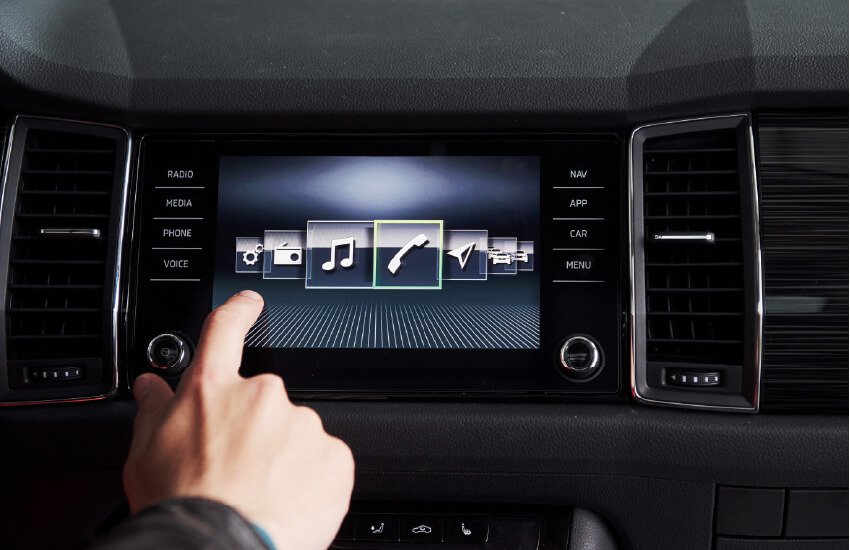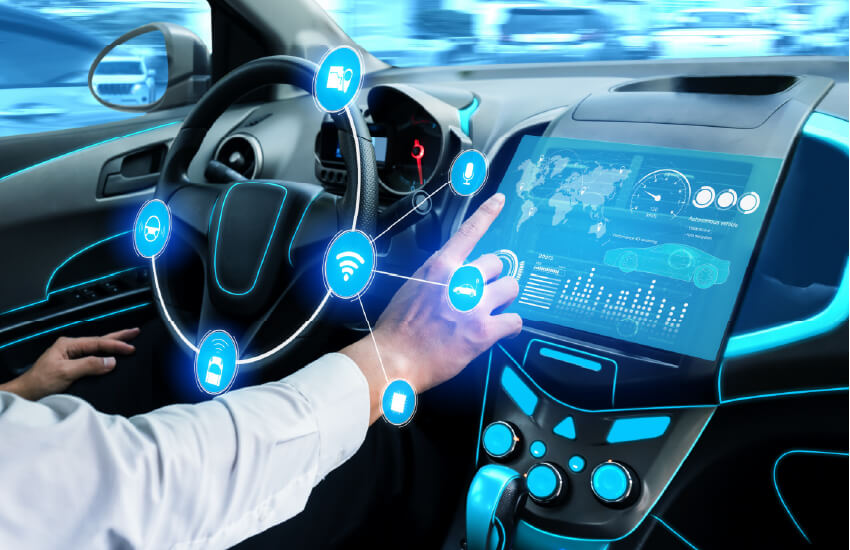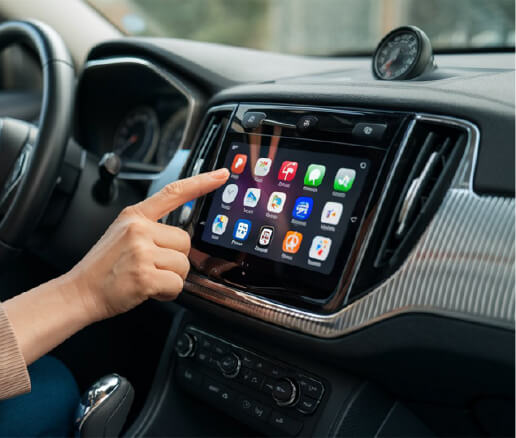What carmakers need from cellular networks to support infotainment in connected vehicles
by Webbing Team | November 25, 2025
Cars are becoming more software-driven and connected each year. As driving becomes more automated, people have more free time in the car, and infotainment starts to play a bigger role in keeping them engaged. Even though fully self-driving cars aren’t here yet, experts say OEMs need to start preparing now. Demand for in-car infotainment systems is rapidly increasing as drivers and passengers look for the same experiences they have in their homes. Some infotainment capabilities are also important for practical reasons – for example, they’re essential for EV drivers who worry about range anxiety.
This growth in demand means that connected cars need more and more data. According to Kaleido Intelligence, increasingly complex infotainment and telematics requirements will almost treble annual automotive data usage over the next 5 years, and the transport and logistics sector will generate over 2 exabytes of cellular data by 2030. They specifically mention infotainment usage as the biggest driver for the increase in data consumption. Analysys Mason forecasts an even larger surge, expecting global cellular data traffic from connected cars to rise from 1800 petabytes in 2023 to 13 500 petabytes in 2029. ABI Research experts reported that in 2024, drivers and passengers were expected to spend about 2 billion hours with in-vehicle infotainment, but that number will skyrocket to almost 12 billion hours annually by 2030.
How can this demand be satisfied in terms of connectivity? The only way that personalized on-demand content (such as Spotify, Netflix, live traffic, and cloud assistants) can reach vehicles on the move is cellular networks, and nothing can replace them, especially on highways and in remote areas.
Indeed, cellular connectivity for connected cars isn’t only about safety and telematics. It is exactly what turns the infotainment system from a simple radio and GPS into a living digital service. The always-on connection that cellular networks provide makes the in-car experience feel as smart and responsive as a smartphone, which directly affects customer satisfaction and brand perception.
For the OEM, it also enables ongoing revenue from subscriptions and data services, plus the ability to update apps and content over the air instead of freezing the experience at the time of sale. Most OEMs bundle low-volume telematics and safety in one package, sell navigation and traffic data as a separate service tier, and treat infotainment and hotspot as a high-volume data add-on.
Let’s take a look at how cellular connectivity enables different infotainment use cases:

Music and Video Streaming
Streaming services like music, podcasts and video are some of the heaviest and most visible infotainment uses. Carmakers are fully aware of how quickly demand for in-car video is rising, and many are already responding. Brands including Tesla, Ford, Jeep, BMW, VinFast, and Porsche have formed partnerships with major streaming platforms to bring Video On Demand (VoD) directly into their vehicles and enable drivers and passengers to watch Netflix, Disney+, Amazon Prime, and other services on in-car displays and rear-seat screens.
Cellular networks provide the constant, high-throughput data pipe needed so content can start quickly and play smoothly. Without a reliable connection, the car either can’t stream at all or has to rely on the user’s phone as a hotspot, which is less consistent and harder for the OEM to control.

Online Navigation, Traffic and Location-Based Services
Modern navigation is far more than static maps. Cellular connectivity lets the car pull live traffic, incident reports, road closures, parking availability, charging station status, and other data. For the driver, this means routes that avoid jams and real-time ETAs. For the OEM, a cellular link enables remote updates to maps and navigation logic without a workshop visit, so navigation turns into a continuously updated service.
Voice Assistants and Cloud-Connected Apps
Many in-car voice assistants depend on cloud processing to recognize speech and understand natural language. Cellular connectivity carries the data between the car and the cloud, and a weak link quickly turns the assistant into something slow or unavailable. Beyond voice, lots of infotainment widgets and apps such as news, weather, and messaging integrations, need frequent small data exchanges, and cellular link lets them stay up to date, so the car feels like an extension of the user’s digital life rather than an isolated device.

In-Car Wi-Fi Hotspot and Passenger Connectivity
When the car acts as a Wi-Fi hotspot, it effectively becomes a moving broadband router for passengers’ phones and laptops. This relies entirely on a solid cellular link to provide enough bandwidth and stability for multiple devices at once. Without embedded cellular, all those devices would have to use their own mobile plans individually, and the OEM would have no way to offer an integrated connectivity package as part of the car.
App Stores, Software Updates and Content Downloads
Many infotainment systems now support in-car app stores, downloadable services, and periodic updates to the head unit itself. Cellular connectivity allows the car to download new apps and update existing ones. This keeps the infotainment platform fresh and lets OEMs fix bugs or improve UX after the car is sold.

Connectivity Requirements for Infotainment
While some of the connectivity requirements of infotainment are common with other connected car applications, some are specific to this kind of data usage.
Coverage
Coverage quality is critical because infotainment is highly visible to drivers and passengers. Slow-loading apps or buffering can immediately damage the perceived quality of the car. OEMs need strong nationwide coverage, including highways and rural areas, as well as multi-operator access when roaming. Redundancy through eSIM and fast handovers help ensure a seamless experience, while poor coverage directly translates into unhappy customers.
Scalability and Compliance with Regulations
Automakers build infotainment systems that are sold across many countries, usually with the same hardware but under different regulatory rules. That means they need a global connectivity approach that works everywhere, while still allowing local data plans and policies in each market. They can also benefit from automatic SIM profile switching using eSIM technology, and from being able to connect to different cloud providers depending on the region. Because of this, OEMs often partner with a global MVNO that handles the complexity of working with dozens of operators in different countries. In certain heavily regulated markets, local rules may also mandate that all elements involved in remote provisioning be operated by a local operator. Here, the connectivity provider’s technical capabilities also become critical – a good example is Webbing’s solution, which was the first to enable seamless localization in Turkey for any IoT deployment, effectively solving the problem of permanent roaming in the country.
Bandwidth
Infotainment relies on high and stable data capacity because it is driven by rich media like music, video, map downloads, and app updates. Connected cars need strong downlink speeds for streaming and enough uplink for cloud-based voice assistants. But, unlike safety systems, infotainment doesn’t need ultra-low latency – what matters is having reliable, predictable capacity so the user experience feels smooth.
Infotainment can consume a huge amount of data, especially with HD video and in-car Wi-Fi hotspots. OEMs need flexible commercial models to manage this cost, ranging from user-paid plans to hybrid models or usage caps and throttling. A connectivity partner that can separate traffic types, prioritize essential services, and control heavy usage can help OEMs manage both performance and cost effectively.

Webbing’s Solution for Connected Cars
Webbing offers a connectivity solution that ensures global access to reliable and high-quality internet, with low latency and the best of class coverage. It provides secure and continuous internet connection, delivering a streamlined, centralized, and scalable means of deploying, controlling and updating connected cars.
Webbing’s connectivity solutions guarantee global coverage, and through our ecosystem of over 600 mobile operators worldwide, devices can roam seamlessly across multiple carriers’ networks in every region. It solves the problem of weak spots that any mobile network may have and ensures full coverage and continuous connectivity for all devices, even at remote locations.
Webbing’s distributed core network with local breakouts, multiple network solution, and data server redundancy can provide OEMs connectivity stability and low latency. It also allows for all types of localization – from IP traffic that remains in the country to designated profiles for emergency calls, so it’s easy to comply with local and regional connectivity regulation requirements.
Our eSIM solution ensures failover connectivity with the capability of using multiple mobile carrier profiles, easily changing carriers at any time with zero integration, and an option to fall back from a failing profile to a different profile without any need to communicate with a remote server. Webbing’s eSIM is aligned with the GSMA SGP.32 IoT eSIM specification. More than 1 million WebbingCTRL eSIMs/SIMs have already been deployed globally since its release.
Webbing also offers a centralized way to manage eSIMs throughout their lifecycle, making deployments future-proof and eliminating the problem of ever-changing legislation on connectivity and data protection. With our solutions, OEMs can set up business rules that would allow connected vehicles to change the serving carrier automatically under specific conditions, such as location, loss of connectivity or even after a certain amount of time, which can be of use for cars shipped to some markets.
A connected car may need more than one billing option because the owner uses infotainment services, while the OEM relies on telematics for diagnostics and remote updates, and these data types should be charged differently. Webbing offers a split billing option with multiple APNs for the same user, allowing for billing customization and different types of plans for different data.
A flexible approach to data packages allows us to tailor our connectivity offering for every customer based on the type of connected devices and their data consumption needs as well as the locations where the devices are used, aiming at overall optimization of the total cost of operations for the client.
Our solutions help connected car manufacturers overcome their connectivity problems and reduce time to market for global deployments, providing the benefits of roaming with multiple carrier options in every country, and seamless transition between carriers, while maintaining low rates and low latency on a global scale.
Webbing’s advanced eSIM technology and global IoT connectivity platform are already used by some car manufacturers. For example, Webbing connectivity delivers seamless, secure, and scalable connectivity to VinFast’s expanding fleet of smart electric vehicles.
Reach out to learn how Webbing’s solutions can help you address any connected vehicle connectivity needs.




